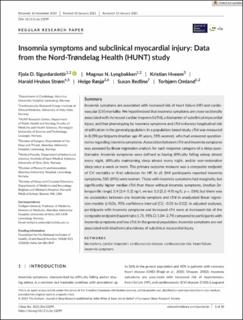| dc.contributor.author | Sigurdardottir, Fjola Dogg | |
| dc.contributor.author | Sigurdardóttir, Fjóla Dögg | |
| dc.contributor.author | Lyngbakken, Magnus | |
| dc.contributor.author | Hveem, Kristian | |
| dc.contributor.author | Hrubos-Strøm, Harald | |
| dc.contributor.author | Røsjø, Helge | |
| dc.contributor.author | Redline, Susan | |
| dc.contributor.author | Omland, Torbjørn | |
| dc.date.accessioned | 2022-02-28T14:53:42Z | |
| dc.date.available | 2022-02-28T14:53:42Z | |
| dc.date.created | 2021-06-24T14:56:53Z | |
| dc.date.issued | 2021 | |
| dc.identifier.citation | Journal of Sleep Research. 2021, 30 (5), . | en_US |
| dc.identifier.issn | 0962-1105 | |
| dc.identifier.uri | https://hdl.handle.net/11250/2981830 | |
| dc.description.abstract | Insomnia symptoms are associated with increased risk of heart failure (HF) and cardiovascular (CV) mortality. We hypothesised that insomnia symptoms are cross-sectionally associated with increased cardiac troponin I (cTnI), a biomarker of subclinical myocardial injury, and that phenotyping by insomnia symptoms and cTnI enhances longitudinal risk stratification in the general population. In a population-based study, cTnI was measured in 8,398 participants (median age 49 years, 55% women), who had answered questionnaires regarding insomnia symptoms. Association between cTnI and insomnia symptoms was assessed by linear regression analysis for each response category of a sleep questionnaire. Insomnia symptoms were defined as having difficulty falling asleep almost every night, difficulty maintaining sleep almost every night, and/or non-restorative sleep once a week or more. The primary outcome measure was a composite endpoint of CV mortality or first admission for HF. In all, 844 participants reported insomnia symptoms, 585 (69%) were women. Those with insomnia symptoms had marginally, but significantly higher median cTnI than those without insomnia symptoms, (median [interquartile range] 3.4 [2.4–5.2] ng/L versus 3.2 [2.2–4.9] ng/L; p = .014), but there was no association between any insomnia symptom and cTnI in unadjusted linear regression models (β 0.06, 95% confidence interval [CI] −0.01 to 0.12). In adjusted analyses, participants with insomnia symptoms and increased cTnI were at increased risk of the composite endpoint (hazard ratio 1.71, 95% CI 1.04–2.79) compared to participants with insomnia symptoms and low cTnI. In the general population, insomnia symptoms are not associated with biochemical evidence of subclinical myocardial injury. | en_US |
| dc.language.iso | eng | en_US |
| dc.publisher | Wiley | en_US |
| dc.rights | Navngivelse 4.0 Internasjonal | * |
| dc.rights.uri | http://creativecommons.org/licenses/by/4.0/deed.no | * |
| dc.title | Insomnia symptoms and subclinical myocardial injury: Data from the Nord-Trøndelag Health (HUNT) study | en_US |
| dc.type | Peer reviewed | en_US |
| dc.type | Journal article | en_US |
| dc.description.version | publishedVersion | en_US |
| dc.source.pagenumber | 10 | en_US |
| dc.source.volume | 30 | en_US |
| dc.source.journal | Journal of Sleep Research | en_US |
| dc.source.issue | 5 | en_US |
| dc.identifier.doi | 10.1111/jsr.13299 | |
| dc.identifier.cristin | 1918204 | |
| dc.relation.project | Norges forskningsråd: 299113 | en_US |
| dc.relation.project | Norges forskningsråd: 248817 | en_US |
| dc.relation.project | Stiftelsen Kristian Gerhard Jebsen: SKGJ-MED-015 | en_US |
| cristin.ispublished | true | |
| cristin.fulltext | original | |
| cristin.qualitycode | 1 | |

